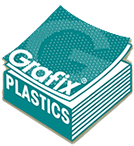Printing on plastic film and sheets is a very common application. However, the techniques used to print on plastics is very detailed. Most often the method and techniques for printing on plastics has to do with the plastic material itself as well as how it is being printed.
The core issue, that drives this area, is the surface energy that any given plastic material has. Surface energy is key with surfaces that don’t absorb liquids. Plastic being different than paper generally doesn’t want to absorb anything, which is why surface energy is important. When a surface has low surface energy, liquids will tend to bead up and not hold their shape, thus not allowing the ink to dry and leave a deliberate formed mark. Different types of inks require different levels of surface energy, in order to “stick.” Different plastics and their respective formulations all have different surface energies. So it is critical, when figuring out whether you can print on plastics, exactly what type of plastic you are using, and understanding the method and inks used to print.
For folks looking to use conventional printing processes like offset litho or screen printing, we always recommend that our customers take a sample of material that they want to print, and provide it to their ink vendors. Ink vendors and do drawdowns and other analytical techniques that will allow them to recommend the right ink and printing techniques to ensure success. That information should always be backed up with test printing.
For folks who are looking to print digitally, the first and most important thing to understand is what equipment is being used to do the printing… laser printer, desktop inkjet printer, commercial wide format inkjet printer, Iris machines, dye sublimation techniques, etc. Once the specific make and model of the equipment is identified than a determination can be made as to how well a given material might work. That information should always be backed up with test printing.
There are a number of different plastic film and sheeting products that Grafix Plastics offers, that are optimized for different printing applications. For example, our DuraLar Polyester Film is available with a pre-treatment on it’s surface, that raises the surface energy enough to be more printer friendly for Offset Lithography and Screen Printing techniques. Our ComputerGrafix product lines feature films that are optimized for Laser Printing, and Desktop Inkjet Printing. Our Acetate and ClearLay products can be printed directly using offset litho, screen printing and solvent, and latex inkjet printing. However, putting either of these two materials through a plain paper copier or laser printer will NOT print, and can cause damage to your equipment.
Most, if not all of our product pages have more specific information about their printability, and machine compatibility. Grafix Plastics has the expertise to help you navigate this complex area and get the results you need.

